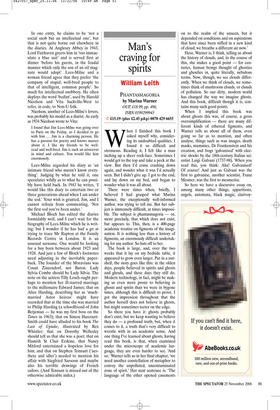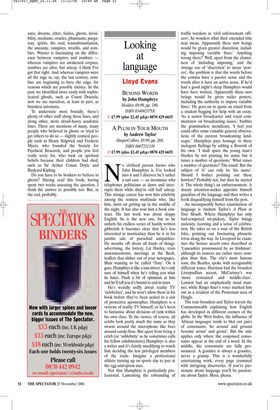Man’s craving for spirits
William Leith
PHANTASMAGORIA by Marina Warner OUP, £18.99, pp. 496, ISBN 0199299943 ✆ £15.19 (plus £2.45 p&p) 0870 429 6655 When I finished this book I asked myself why, considering its undoubted qualities, I found it so difficult and strenuous. Reading it, I felt like a man inching up a sheer rock-face. Sometimes I would get to the top and take a peek at the view. But then I’d come crashing down again, and wonder what it was I’d actually seen. But I didn’t give up. I got to the end, and lay down on my bed, and began to wonder what it was all about.
There were times when, briefly, I believed I had grasped what Marina Warner, the exceptionally well-informed author, was trying to tell me. But her subject is immensely difficult, at times impossible. The subject is phantasmagoria — or, more precisely, that which does not exist, but appears to. This, then, is a 400-page academic treatise on figments of the imagination. It is nothing less than a history of figments, an enormously difficult undertaking for any author. So hats off to her.
The book is large, and, over the two weeks that it lay on my bedside table, it appeared to grow even larger. Put in a nutshell, the story goes like this: in the olden days, people believed in spirits and ghosts and ghouls, and these days they still do. Modern technology, in fact, might be making us even more prone to believing in ghosts and spirits than we were in bygone times, although this is difficult to prove. I got the impression throughout that the author herself does not believe in ghosts, but might sometimes teeter on the edge.
So there you have it: ghosts probably don’t exist, but we keep wanting to believe they do — a profound truth, but, when it comes to it, a truth that’s very difficult to wrestle with in an academic sense. And one thing I’ve learned about ghosts, having read this book, is that, when examined under the microscope of academic language, they are even harder to see. ‘And so,’ Warner tells us in her final chapter, ‘we need another constellation of metaphor to convey the unpolluted, uncontaminated zone of spirit.’ Her next sentence is: ‘The language of the ether opened casements on to the realm of the unseen, but it depended on conditions and on aspirations that have since been stifled in a new kind of cloud; we breathe a different air now.’ Here, Warner is, I think, telling us about the history of clouds, and, in the course of this, she makes a good point — for centuries, human beings thought of ghosties and ghoulies in, quite literally, nebulous terms. Now, though, we see clouds differently. When we think of clouds, we sometimes think of mushroom clouds, or clouds of pollution. So our dirty, modern world has changed the way we imagine ghosts. And this book, difficult though it is, contains many such good points.
When I implied this book was about ghosts this was, of course, a gross oversimplification — there are many different kinds of ethereal figments, and Warner tells us about all of them, even going so far as to mention, and often analyse, things such as wax images, death masks, mummies, Dr Frankenstein and his creation, and frogs ‘galvanised’ with electric shocks by the 18th-century Italian scientist Luigi Galvani (1737-98). When you read this, you think: Aha! Galvanised! Of course! And just as Galvani was the first to galvanise, another scientist, Franz Mesmer, was the first to mesmerise.
So here we have a discursive essay on, among many other things, apparitions, angels, automata, black magic, clairvoy ance, dreams, ether, fairies, ghosts, invisibility, mediums, oracles, phantasms, purgatory, spirits, the soul, transubstantiation, the uncanny, vampires, wraiths, and zombies. Warner is fascinating on the difference between vampires and zombies whereas vampires are awakened corpses, zombies are alive, but asleep. I think I’ve got that right. And, whereas vampires were all the rage in, say, the last century, zombies are beginning to have the edge, for reasons which are possibly sinister. In the past, we identified more easily with sophisticated ghouls, such as Count Dracula; now we see ourselves, at least in part, as brainless automata.
To understate most brutally, there’s plenty of other stuff along these lines, and along other, more detail-heavy academic lines. There are mentions of many, many people who believed in ghosts or tried to get others to do so — slightly comical people such as Henry Sidgwick and Frederic Myers, who founded the Society for Psychical Research, and people you feel really sorry for, who took on spiritual beliefs because their children had died, such as Sir Arthur Conan Doyle and Rudyard Kipling.
Do you have to be bonkers to believe in ghosts? Having read this book, having spent two weeks assessing the question, I think the answer is: possibly not. But, in the end, probably.



























































































 Previous page
Previous page